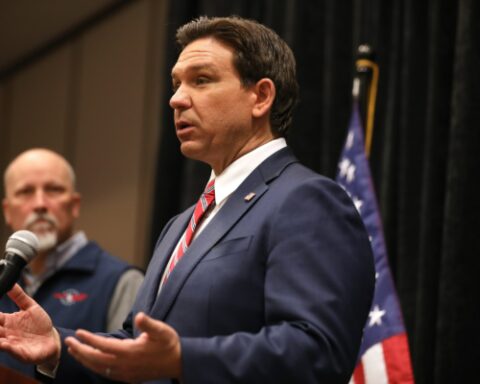Governor Ron DeSantis on Monday reportedly announced the completion of the Crane Creek M1 Canal Flow Restoration project, underscoring what he says has been a central priority since taking office: protecting and restoring Florida’s waterways through targeted, results-driven investment.
The century-old canal, built to control flooding, had long disrupted the natural westward water flow between the St. John’s River and the Indian River Lagoon.
Over time, stormwater runoff from nearby communities pushed harmful nutrients into the lagoon, fueling algae blooms, damaging habitats, and threatening both local wildlife and the tourism economy.
Standing before reporters, DeSantis described the newly completed restoration project as both an environmental and economic win.
By adding a new weir pump station, a pipeline, and a stormwater treatment area, the state has restored the original westward flow, reduced nutrient pollution entering the lagoon, and ensured a steady supply of up to 7 million gallons of fresh water per day for downstream use — without overburdening the aquifer.
“There are a lot of problems in this state, starting with the Florida Everglades and even jewels like the Indian River Lagoon,” DeSantis said. “So we said we’re going to do something about it. We put our money where our mouth is. We launched a very ambitious project for environmental stewardship, and the results have been really fantastic, but we’re not done yet.”
The numbers behind the governor’s environmental push are substantial. Since he took office, more than $3.3 billion has been awarded to over 1,000 projects aimed at safeguarding Florida’s natural resources. State officials say these efforts have already removed more than 4.8 million pounds of nitrogen and nearly 900,000 pounds of phosphorus from waterways annually.
More than 250 projects have already been completed, with additional initiatives underway to address the needs of Florida’s rapidly growing population.
Removing nitrogen and phosphorus, scientists note, is critical to preventing harmful algae blooms, fish kills, and the long-term decline of ecosystems that support both tourism and drinking water supplies for millions of Floridians.
DeSantis also stressed his administration’s focus on expanding alternative water supply sources. Earlier this year, the state awarded more than $389 million in grants for further water quality and quantity improvements.
Of that, $100 million went directly to the Indian River Lagoon Protection Program — protecting what scientists call the most biologically diverse estuary in North America.
“These projects alone are projected to remove more than 1.1 million additional pounds of nitrogen and almost 300,000 pounds of phosphorus each year,” DeSantis said.
Looking ahead, the governor has proposed $460 million for water quality improvements and $50 million for the alternative water supply grant program in the fiscal 2025–2026 budget.
The completion of the Crane Creek restoration, he argued, is proof that state-led, locally focused initiatives can yield measurable improvements — a model that, in his view, delivers more value to Floridians than federal mandates or one-size-fits-all regulations.
[READ MORE: Trump Weighs Inviting Zelensky to Alaska Peace Talks With Putin]








